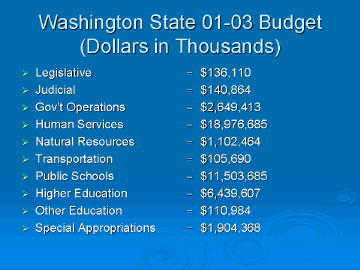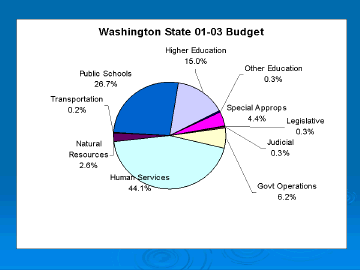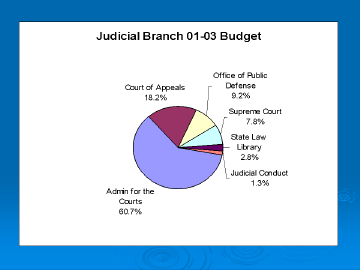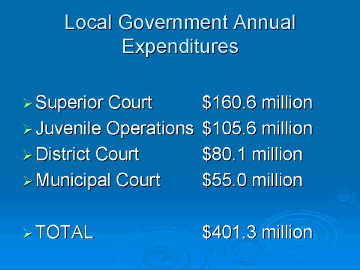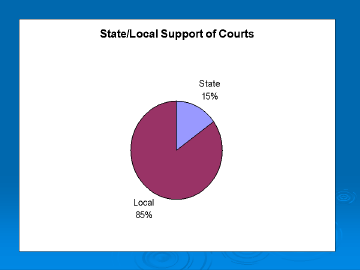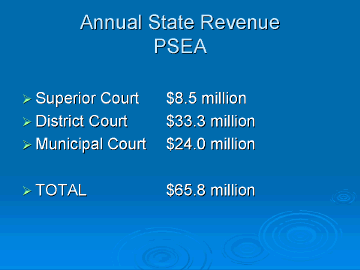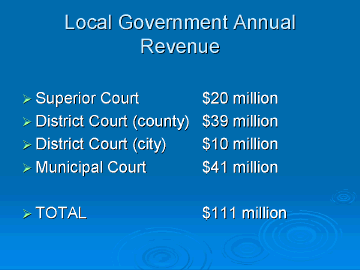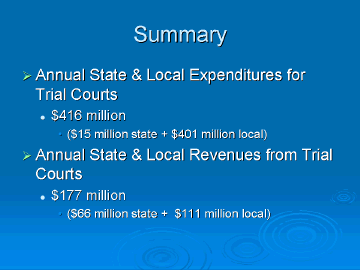Court Funding Task ForceOctober 7, 2002Members present: Mr. M. Wayne Blair, chair; Mr. Jeff Amram; Ms. Cheryl Bleakney; Mr. John Cary; Commissioner Mike Chapman; Ms. Edsonya Charles; Mr. John Connelly, Jr.; Mr. David Donnan; Judge Stephen Dwyer; Mr. Tim Ferrell for Senator Kastama; Ms. Joan Ferebee; Judge Deborah Fleck; Judge Gordon Godfrey; Judge Robert Harris; Senator Mike Hewitt; Mr. Roland Hjorth; Ms. Rena Hollis; Judge Stephen Holman; Ms. Mellani Hughes; Mr. James Kirkham Johns; Representative Ruth Kagi; Judge Dirk Marler; Ms. Mary McQueen; Judge James M. Murphy; Judge Kathleen O’Connor; Judge Michael P. Roewe; Mr. Mike Runyan; Mr. Robby Stern; and Mr. Ron Ward Guests present: Chief Justice Gerry Alexander; Mr. Doug Levy; Mr. James E. Macpherson; Mr. J. Richard Manning; and Mr. Steven G. Toole Staff present: Mr. Gil Austin; Ms. Jude Cryderman; Mr. Doug Haake; Ms. Janet McLane and Ms. Yvonne Pettus Welcome Chief Justice Alexander welcomed the members. He thanked them for agreeing to participate in this important undertaking. Chief Justice Alexander introduced Wayne Blair, chair of the Task Force. Introductions Mr. Blair asked the members to introduce themselves. History Chief Justice Alexander provided a brief history of the creation of the task force. The Chief Justice advised that the Superior Court Judges and the District and Municipal Court Judges’ Associations ha requested that the Board for Judicial Administration create a task to study and make recommendations for adequate funding for Washington’s trial courts. He continued, no one was more qualified than Mr. Blair to chair the Task Force. Chief Justice Alexander reported the steering committee adopted the following as the mission statement for the Task Force: To develop and implement a plan to achieve stable, adequate, long term funding of Washington’s trial courts to provide equal justice throughout the state. Mission of Task Force Superior Court Judges’ Association Judge Fleck thanked Mr. Blair for agreeing to chair the Task Force. Judge Fleck advised that Washington ranks 50th among the states in terms of the percentage of funding provided to the trial courts by the state. She indicated the trial courts have lacked adequate funding over the past 20 years. Judge Fleck reported over the years, many task forces, commissions, etc., have studied court funding and issues related to court funding. In particular, one of the recommendation of the Commission on Justice, Efficiency and Accountability was: 10.3 The Board for Judicial Administration should develop an overall funding strategy for the judiciary, consistent with the long-range plan including consideration of Initiative 62. Recommendations from the Commission on Washington Trial Courts included: 4.1 The superior courts should have adequate facilities for normal operations, and should have an adequate level of security within those facilities. 4.2 The superior courts should have adequate personnel, and should be able to offer an adequate level of services to the public, including pro se litigants. Judge Fleck identified some of the current problems:
Judge Fleck continued, the Task Force should review the core functions of the courts; consider appropriate source of funding and develop strategic plan. District and Municipal Court Judges’ Association Judge Marler stated that it is time to take a closer look at how the courts are funded. He continued, many legislative policy changes have costs or increase workloads without funding from the state, which in turn is a burden for local government. Judge Marler reported the District and Municipal Court Judges’ Association conducted a survey of its membership. Some of the problems that were identified in the survey:
Reasons to look a court funding identified in survey are:
Washington State Bar Association Mr. Manning stated the Bar supports the Court Funding Task Force because of the threat to the independence of the judiciary. Other reasons for the Bar’s support include:
Washington State Trial Lawyers Association Mr. Toole reported WSTLA is committed to access to justice. He advised WSTLA has been expending much effort in an attempt to save mandatory arbitration. He continued, WSTLA’s Judicial Relations Committee is available to assist the Task Force. King County Bar Association Mr. Cary pointed out every year the crisis is greater and greater. He indicated, the budget problems have changed over the years. In the past, additional judges were added, now additional administrative staff are necessary to assist the judges in working more effectively and efficiently. Mr. Cary continued, court funding is a priority for KCBA, not only locally but state-wide. He said, although the answers for court funding are not clear, the process of getting there might be just as crucial as the end result. Civil Defense Bar Mr. Macpherson reported the Civil Defense Bar is interested in preserving the system, but they are not in a position to determine whether just efficiencies will save the system without additional dollars. Legislature Representative Kagi stated many legislators understand the dilemma facing the courts. She continued, the gap analysis is just one side of the problem—how to fill the gap is equally important. Senator Hewitt reminded the members that with the passing of I-695 money was taken away from local government. In addition I-728 and I-732 cost taxpayers $800-900 million per biennium. Others Chief Justice Alexander advised that the courts are not an agency of state government, but are a separate branch of government—just as the legislature is. Judge Godfrey advised that HB 2392 created a task force to study unfunded mandates. The task force’s interim report was unfavorable towards the legislature’s practice of not funding mandates. He continued, in 2001 the legislature terminated the task force before a final report was produced. Judge Godfrey stated the source of court funding is under the constitution. The court system is not a pay as you go system. The State Budget – how it works Mr. Moore provided an overview of the budget and taxes (handouts at meeting) in Washington State. He pointed out that the general fund has semi-discretionary dollars which are collected at the state level. Forty-two percent of the general fund dollars are allocated to public schools. Eighty percent of the schools’ allocation goes to salaries. He continued, only three percent of the general fund dollars goes to government operations, which includes courts. Mr. Moore pointed out:
Mr. Moore advised the members that the state will experience between a $1.3 and $2.5 billion deficit during the 2003-2005 biennium. The group discussed the budget. Future Meetings The Task Force agreed to meet next in November. The members indicated that Mondays are the preferred meeting day. Review of Washington’s Court Funding Efforts Ms. McQueen reviewed the following court funding efforts:
Ms. McQueen reviewed efforts made by other states.
Other States’ Recommendations
Court System Expenditures and Revenues Ms. McLane reviewed the following materials.
Work Plan Mr. Blair explained the first and second meetings would focus on the current court system, i.e., revenue, revenue distribution to state/counties/cities. Possible questions to be for the task force to ask are:
Mr. Blair continued, the Commission on Justice, Efficiency and Accountability attempted to define the “core mission” of the courts, along with establishing minimum standards for courts. The Project 2001 group conducted a major effort to identify ways in which the courts might be more effective and efficient. Mr. Blair continued his overview of the work of the Project 2001 Committee. The group continued discussion relating to the work plan. Additional information was requested relating to the expansion of PSEA—what has changed since inception in terms of additional groups getting money from PSEA funds. In addition, presiding judge and court administrators will be asked to provide budget information based on needs, not wants of the courts. The Task Force agreed it might be helpful to have the court administrators and county clerks identify those responsibilities they are doing now, but with a little additional funding they could do better. They also agreed examples of unfunded mandates from the SCJA and DMCJA would be helpful. The group agreed that they should not just define the problem, but define solutions. Other Business There being no further business, the meeting was adjourned. |




Privacy and Disclaimer Notices Sitemap
© Copyright 2025. Washington State Administrative Office of the Courts.
S3

